仓库运营最佳实践:改善仓库管理、组织和运营的 55 个绝妙技巧和策略
仓库经理非常清楚,管理仓库设施运营的任务远非简单。仓库运营经理的任务是确保产品进出设施的高效流动,优化建筑物的布局,确保订单得到履行,产品有库存,但不会积压。再加上确保盈利能力并最大限度地降低管理费用和劳动力成本,仓库运营商的工作量就大大减少了。
有这么多因素需要平衡,每个决策都需要考虑,以及来自各方利益相关者的压力为了提高生产力、最大限度地减少开支并保持顺畅的供应链流程,有许多文章和资源概述了仓库运营的最佳实践也就不足为奇了。
为了分析有关仓库运营最佳实践的大量信息,我们从各种来源汇总了一份相对简洁的最佳实践列表。我们搜索了网络的各个角落,确定了这 51 种仓库运营最佳实践,为仓库经理提供了有用的资源,旨在成为所在领域的佼佼者,并为他们的公司创造可能的最佳结果。虽然按主题分类,但请注意,以下最佳实践并未按任何特定的重要性顺序进行评级或排名。要跳转到特定部分,请使用下面目录中的链接。
55 仓库运营最佳实践
目录:
- 仓库运营的资产跟踪最佳做法
- 仓库运营物流最佳实践
- 仓库运营中的安全和风险管理
- 优化仓库运营工作流程
- 改善库存管理的最佳做法
仓库运营的资产跟踪最佳实践
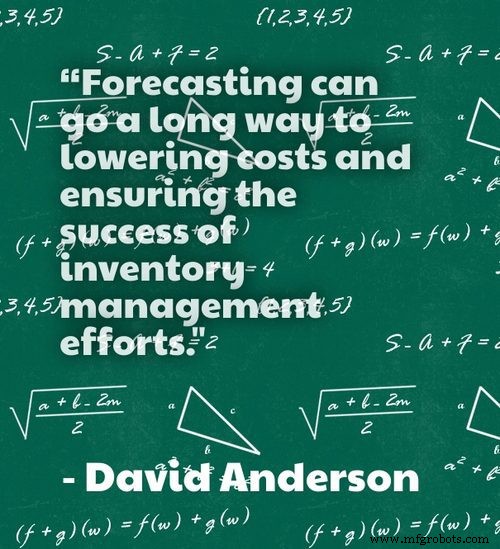
1.使用自动数据收集。 “‘人们在纸本上写数字或在键盘上输入一串数字是一个不好的信号,’McKnight 说。
自动数据收集(通过条形码和射频识别)的好处是公认的,包括提高生产力和准确性以及降低劳动力成本。但是许多公司仍然没有实施自动数据收集。
“一些拥有 30,000 或 40,000 个项目编号和多个设施的组织仍然相信,如果没有技术,他们会更好,”McKnight 说。 – Denny McKnight,Tompkins Associates Inc. 的合伙人,该公司是一家总部位于北卡罗来纳州罗利的供应链集成公司,Leslie Hansen Harps 在当今配送中心的最佳实践中引用 , InboundLogistics.com
2.不要依赖手动数据输入流程。 “INSTEAD:在收货码头使用带有条形码扫描仪或 RFID 阅读器的移动数据终端,以便在产品到达时立即识别。这有助于快速将产品送出码头,并消除几乎所有与手动接收相关的错误:包括识别、计数和数据输入错误。借助扫描和 RFID 技术,您将避免那些严重破坏库存准确性并消耗时间和资源来修复的错误。这意味着您的仓库员工可以专注于更快地处理客户订单。” – 十大亏损仓库策略以及如何避免它们 ,摩托罗拉解决方案;推特:@MotoSolutions
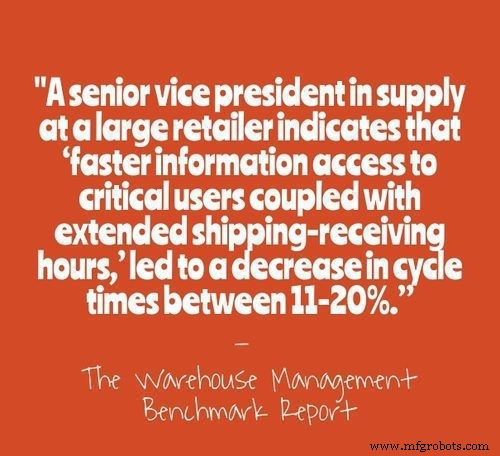
3.在全公司范围内提高信息可见度。 “一流的产品指向广泛扩展的仓库可见性基础设施,使他们能够在整个运营过程和整个公司内共享信息。另一位受访者指出可见性是改进的一种手段。一家大型零售商的供应高级副总裁表示,‘关键用户的信息访问速度更快,收货时间更长’,导致周期时间减少了 11-20%。” – 仓库管理基准报告 ,安本集团;推特:@aberdeengroup
4.资产跟踪与仓库管理系统 (WMS) 相结合,提供了最大限度提高仓库生产力所需的自动化。 “聪明的企业明白,控制库存、履行和运输成本对于成功至关重要。公司不断努力通过提高敏捷性、可见性和劳动效率来改善其仓库运营。这需要将最佳实践与复杂的仓库管理系统 (WMS) 结合使用,以优化管理配送业务中的所有资源,同时最大限度地降低总运营成本或拥有成本 (TCO)。” – 仓库和配送:简化您的配送流程并让您的客户满意 , 网络套件;推特:@NetSuite
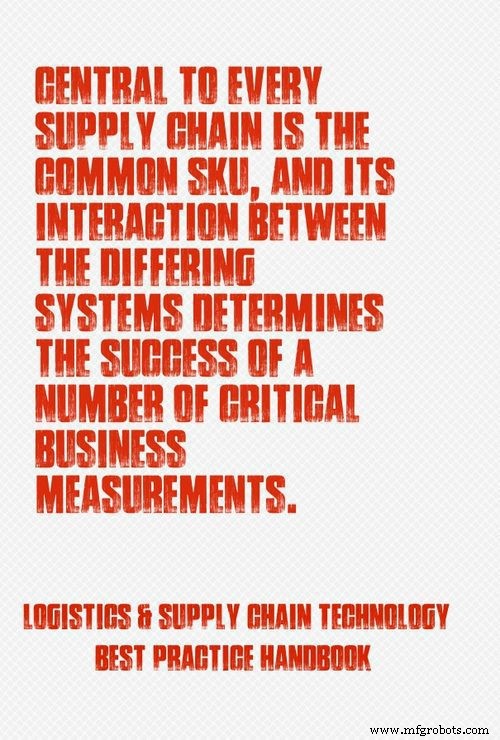
5.数据同步提高了可见性并简化了通常的劳动密集型数据集成任务。 “每个供应链的核心是通用 SKU,它在不同系统之间的交互决定了许多关键业务测量的成功与否。在任何规模的组织中协调跨复杂软件应用程序套件的数据流的关键是在企业内水平或垂直同步与通用 SKU 相关的所有数据。这种在系统级别标准化通用产品数据并且没有数据转换障碍的方法正在迅速取代劳动密集型的数据集成任务。组织之间数据交易的下一个演进阶段是使用直接来自供应商的最新 SKU 信息更新数据存储库。这种可互操作数据的传输现在处于全球和具有成本效益的水平,可以无缝升级库存存储库,消除重新键入并减少互误。在 SKU 信息的连续性对于 WMS、BOS 和 POS 投资至关重要的情况下,它将成为最佳实践。一种数据来源是有道理的。结果——零售商、供应商和消费者都成为赢家。大多数公司的目标是消除退货和重新交付;减少供应链罚款或拒付;提供更好的发票匹配和库存,我们可能有一天会谈论碳
指纹而不是碳足迹。” – 物流和供应链技术最佳实践手册 , 巴斯达;推特:@BASDAUK
6.使用垃圾箱位置快速定位产品。 “您是否使用垃圾箱位置来定位您的产品?当今可用的绝大多数分发软件包都使用 bin 位置。这允许在您的陈列室和仓库区域内立即、准确地定位产品。许多分销商对利用此工具持谨慎态度,因为他们认为需要将供应商线保持在一起。事实上,Bin 位置让您可以根据销量来定位产品,从而减少挑选那些往往会出现在大多数订单上的关键物品所需的脚步数。我称之为通过速度等级来定位你的产品。
“你能通过‘温度测试’吗?您是否能够聘请新员工或临时员工,并确信此人在两到三个小时内就能发挥作用?利用垃圾箱位置为新招募人员提供了一张地图。这使您可以寻找材料处理领域的熟练人员。如果没有垃圾箱位置,您将需要寻找在您携带的产品线中经验丰富的人,以便找到满足订单的产品。他们将需要更多的手来了解这些不同的产品线在您的四堵墙内的位置。” – Dan Belanger,高效(安全)仓库运营的注意事项 , 气体和焊接经销商协会 (GAWDA);推特:@GasWeldEdge
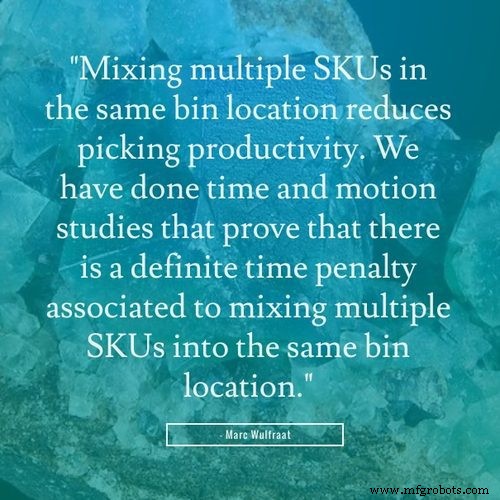
7.请勿将多个 SKU 混合在一个垃圾箱位置。 “在同一个库位混合多个 SKU 会降低拣货效率。我们进行了时间和运动研究,证明将多个 SKU 混合到同一个库位会产生一定的时间损失。
“我们在许多仓库中看到这一点,其中一个库位可能代表包含 5 个货架层– 10 个 SKU 选择面。操作员被引导到货架层,然后需要搜索不同的 SKU 以找到要挑选的商品。
“这不仅会降低准确性,还会使操作员的速度降低多达 15 秒以上每个选择交易。规则 1 是每个 SKU 都有一个离散的拣货位置。” – MWPVL 总裁 Marc Wulfraat,提高订单拣货效率的 5 种方法 , 供应链247;推特:@SupplyChain247
8.使用资产跟踪系统记录在特定时间范围内挑选库存的次数。 “有时库存产品可能没有意义。例如,如果一件物品一年只挑选五次,则可以通过制造商的直接运输来消除存储成本。通过记录产品被挑选的次数,您可以确定库存所在空间的价值。” - 最佳实践 - 库存管理 , 促销执行中心;推特:@PFCFulfillment

9.资产跟踪可实现更准确的预测,这对于降低成本和改进库存管理至关重要。 “预测可以大大降低成本并确保库存管理工作的成功。当零售商能够准确预测他们需要哪些商品和正确的数量时,他们将更适合满足客户的期望,而不会出现多余的库存。更好的预测需要对市场研究、市场需求模型、需求模式、最低库存水平和历史技术的敏锐观察,并且可以在成功的库存管理中发挥巨大作用。” – David Anderson,三个库存管理最佳实践 , 销售扭曲;推特:@SalesWarp

10.使用唯一的跟踪号,而不是资产的序列号。 “一项资产的序列号可能与另一项资产的序列号相同。如果使用序列号作为跟踪号,重复的数字会造成混淆,因为无法区分两种资产。这可能会损害数据完整性并导致客户余额和库存不准确,降低您的租金收入并影响客户满意度。使用不同于序列号的唯一跟踪号可以消除这些问题。在极少数情况下丢失跟踪号,仍然可以使用其序列号查找资产并正确重新标记以保留资产的历史记录。” – Christine Span,资产跟踪最佳实践五强 , 跟踪关于;推特:@trackabout
仓库运营物流最佳实践
11.建立提前发货通知。 “这似乎很简单,但许多配送中心仍未实施电子传输的高级运输通知 (ASN)。依赖“定期”的发货和收货时间表可能会导致整个配送中心的效率低下。延误发生,中断发生——这会导致偏离“常规”时间表。由此产生的问题始于收货码头的人员配备不当,并波及整个仓库。但是,通过利用采购订单和库存管理功能中的电子高级运输通知,可以更加确定地计划劳动力。可以调整订单履行和运输活动以确保满足适当的服务时间要求,并优化运输模式以降低成本。” – 11 仓库和配送中心供应链最佳实践 , 传统供应链服务
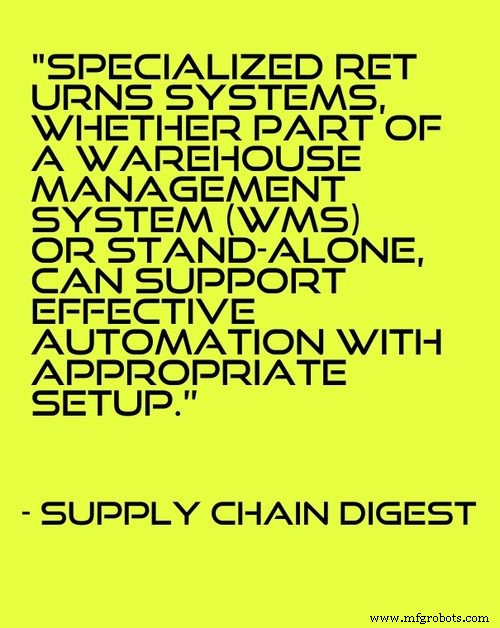
12.实施高效的退货流程。 “退货从根本上说是复杂的,因为它们如何影响实物库存、电子库存和会计系统。必须识别所有项目,将其分配给客户或帐户,分配处置,然后进行物理分类以进行处理。由于某些产品可能会被丢弃或保留以供供应商拒付,因此并非所有商品都进入电子库存;某些商品必须重新包装并以手动方式而非电子方式进行核算。最后,信用额度通常在稍后时间发放,并且通常仅用于退货的一部分,包括丢弃或无法销售的商品。这个过程很难用通用的 ERP 包实现自动化,而且用简单的纸质流程非常具有挑战性。专业的退货系统,无论是仓库管理系统 (WMS) 的一部分还是独立的,都可以通过适当的设置支持有效的自动化。” – 专家见解:仓库退货的最佳实践 ,供应链文摘;推特:@scdigest
13.高效处理任务,避免拖延。 “有时当你从供应商那里收到大宗货物时,很容易给它一个‘ol’,“嗯。让我们稍后再处理这件事。”结束拖延,花时间分解盒子,将它们推入回收箱,解开您的产品包装并相应地储存它们。这是你必须坚持的习惯。如果您的货件每天/每周大约在同一时间送达,请在您的日历上安排。推迟它只会让它变成更大的野兽,等待你的关注。
“如果你没有时间将它们放在货架上,我以前在零售店工作时会做的另一件事是会拿走所有的箱子并把它们排成一行。打开每一个,看看里面有什么。从那里,在每个盒子里做一个迷你长袜堆。知道它们最终将被安置在哪里,将近距离物品放在一起,这样您就可以将它们拉到仓库地板上的正确位置并快速储存。” – Breena Fain,优化仓库管理系统的 6 种方法 , 缝合实验室;推特:@StitchLabs
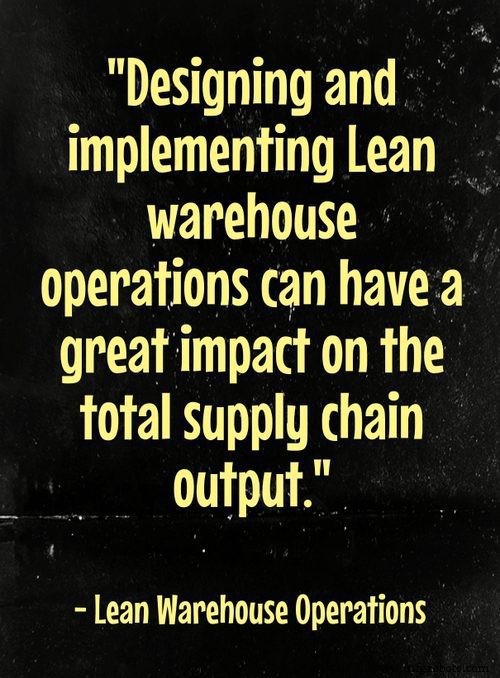
14.实施精益仓库运营实践。 “设计和实施精益仓库操作会对整个供应链产出产生重大影响。通过使用精益解决方案处理上述废物重点领域,可以减少仓储交货时间的一些机会包括:
- 减少订单拣选、上架、码垛和运输过程中的材料处理时间。
- 协调供应链其余部分的信息的可靠性。
- 减少卡车和集装箱的装卸时间。
- 减少检查和寻找库存的时间。
- 提高了适应不断变化的市场条件和客户规格的灵活性。” – 精益仓库运营 , 四大原则
15。控制进出境货运以降低这方面的成本。 “虚拟图书馆中充斥着关于如何降低或减缓这一成本领域的文章。防止利润流失必须是您持续关注的第一要务。聘请顾问帮助您进行有竞争力的投标。虽然运营商协议是专有的,但经验丰富的顾问仍然可以帮助确定在不损害服务水平的情况下协商减少的领域。” – Curt Barry,提高仓库效率和降低成本的 10 种方法 ,多渠道商户;推特:@mcmerchant
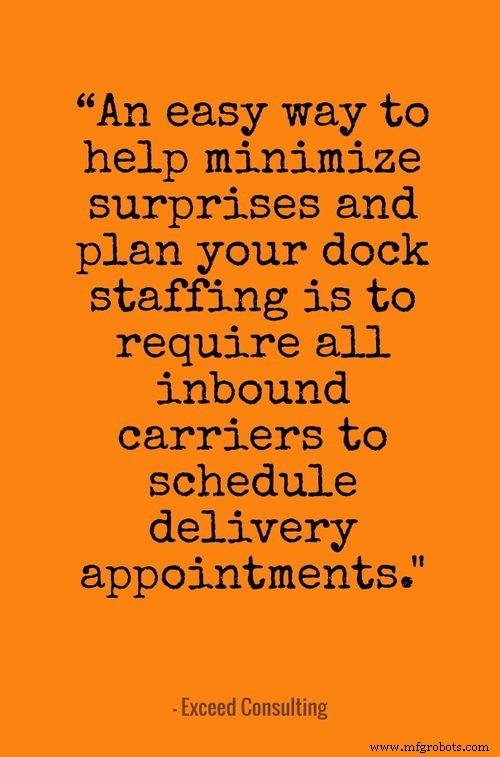
16.要求供应商接受预约。 “帮助减少意外和规划码头人员配备的一种简单方法是要求所有入境承运人安排交货预约。有两种不同的调度方法,它们可以同时使用。第一种方法是简单地为每个承运人或交付分配一个特定的时间或时间窗口来交付。第二个是分配一个特定的或重复的每日、每周或每月计划到达。这使您可以相应地安排员工并充分利用您的码头。如果您共享一个码头或将入站和出站运送到同一区域,供应商接收预约绝对至关重要。任何预先的文书工作或数据应在交付前提供。通过要求预约和有关传入负载的信息,可以最大限度地减少意外。” – 回归基础,第 1 部分:接收 , 超越咨询
17.进行 ABC 分析,这有助于按价值对库存进行分类。 “ABC 是您最有价值的物品的层次结构(按美元价值)。这也称为库存分类方法。由于您可能不会平等地评估您的整个库存,因此此控制将使您将时间和资源集中在最赚钱的项目上。
“A- 项目是大件或优先股。这些商品需要更严格的控制和监控,因为它们是您最大的收入和成本贡献者。由于它们的成本,您很可能手头携带的数量较少。由于这些物品备受追捧,因此应将它们存放在“锁和钥匙”之下。除了安全性之外,A-list 产品还需要更高频率的库存审查和重新订购。这可确保您有足够的供应。
“相反,C 类物品的价值较低,但您可能携带大量它们。例如,如果您拥有一家五金店,那么散装的钉子可能会被视为 C 项。 B-items 在价值、数量、库存审查和重新订购频率方面处于中间位置。” – Colleen Rodericks,库存管理技术和最佳实践 ,流入;推特:@inFlowInventory
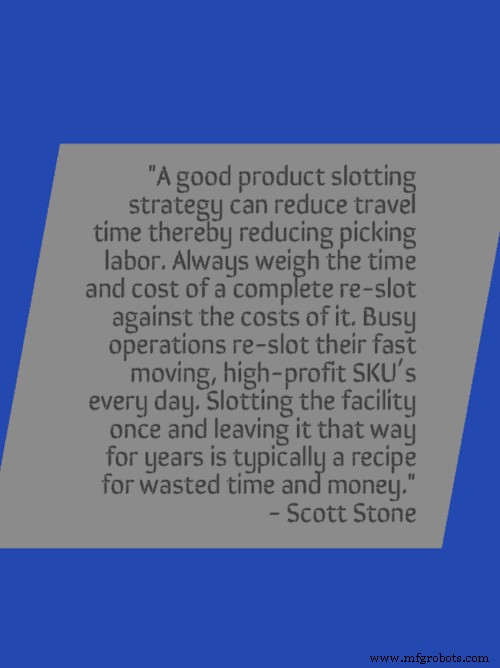
18.根据需要经常更换您的选择位置。 “多达 60% 的采摘者日常活动可能涉及旅行时间(步行、叉车或步行),因此减少时间花费是一个好主意。一个好的产品开槽策略可以减少旅行时间,从而减少拣货劳动力。始终权衡完整重新插槽的时间和成本与其成本。繁忙的运营每天都在重新安排他们快速移动、高利润的 SKU。将设施开槽一次并保持这种状态多年通常会浪费时间和金钱。” – Scott Stone,13 仓库生产力最佳实践, 思科鹰;推特:@CiscoEagle
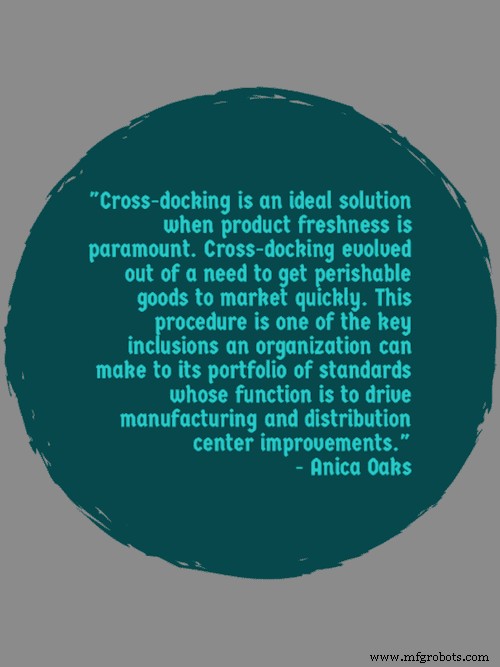
19.尽可能利用越库。 “卓越的物流规划包括尽可能多的交叉对接。交叉对接是从进货车辆卸下材料并立即将这些相同材料直接装载到出境车辆上的做法,其间的仓储间隔最小或为零。将此视为“准时”运输。当产品新鲜度至关重要时,交叉对接是理想的解决方案。越库配送源于将易腐货物快速推向市场的需要。此程序是组织可以对其标准组合进行的关键内容之一,其功能是推动制造和配送中心的改进。” – Anica Oaks,5 仓库精益最佳实践, Apriso 制造转型博客;推特:@Apriso
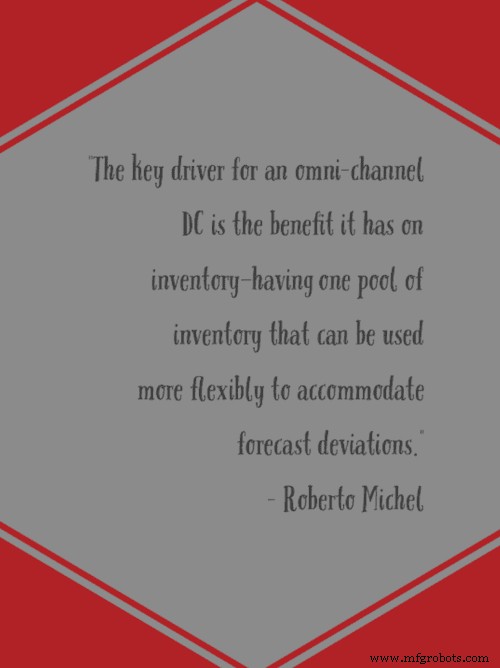
20.创建配送多个渠道订单的配送中心。 Commonwealth Supply Chain Advisors 创始人兼董事总经理 Ian Hobkirk 表示:“对于一些寻求全渠道履行效率的公司来说,趋势是从专注于单一渠道的 DC 转向为多个渠道履行订单的 DC。 .
“‘十年前,当电子商务还很新的时候,公司在建立和运营数据中心的方式上存在很多渠道分离,在很多情况下,电子商务的履行被外包给了3PL,”霍布柯克说。 “我们现在在零售商中看到的趋势之一是拥有多渠道配送中心,所有渠道的库存和配送都在同一屋檐下。”
“全渠道配送中心的关键驱动力是它对库存的好处——拥有一个库存池,可以更灵活地使用以适应预测偏差。 “还有其他因素推动了全渠道履行中心的发展,例如能够使用共同的劳动力池降低成本,但真正推动这一趋势的是库存因素,”Hobkirk 说。
“上升全渠道履行使库存管理更加复杂,从而提高了对更好的执行、预测协作和管理报告系统的需求,包括仓库管理系统 (WMS)、企业资源规划 (ERP) 以及需求管理和交叉- 学科合作,供应链咨询公司 St. Onge Company 的高级顾问 Don Derewecki 说。 – Roberto Michel,仓库/配送中心管理:改善库存管理的六个最佳实践 ,物流管理;推特:@LogisticsMgmt
仓库运营中的安全和风险管理
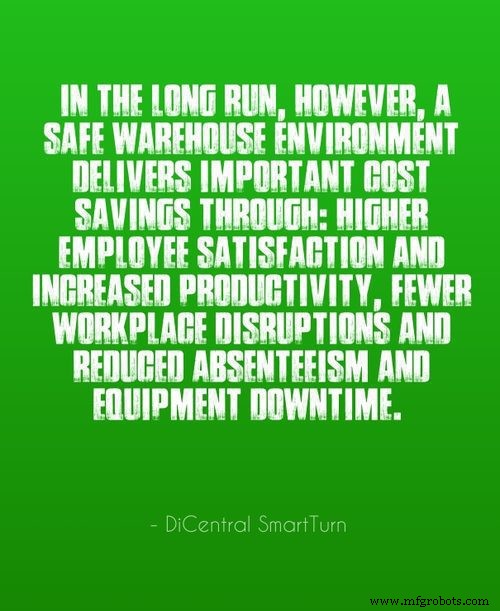
21.将仓库安全放在首位。 “仓库安全不仅仅是遵守消防法规和 OSHA 规定。不幸的是,太多的仓库和 3PL 将安全视为满足法律规定的最低要求或他们的良心。通常,两者都远远不够。在本章中,我们将研究仓库安全的最佳实践,讨论在仓库中建立安全文化以及未能做到这一点对员工、经理和雇主的好处和风险。对于那些未能促进安全的公司来说,往往是因为时间不够、资源不足,或者是因为偷工减料省钱的机会。然而,从长远来看,安全的仓库环境可以通过以下方式显着节省成本:提高员工满意度和生产力、减少工作场所中断以及减少缺勤和设备停机时间。您可以延长仓库基础设施(例如存储和物料搬运设备)的使用寿命,并减少对库存的损坏。最重要的是,不要以为安全的工作场所会带来令人瞠目结舌的价格标签。” – 库存和仓库管理最佳实践 , DiCentral SmartTurn;推特:@DiCentral_EDI
22.成立安全委员会。 “虽然不是特别严重,但仓库事故很多——根据美国劳工统计局的数据,仓储和仓储行业每年会经历近 15,000 人受伤和生病。
“为了控制事故,仓库经营者应该强调仓储教育和研究委员会 (WERC) 的执行董事 Bob Shaunnessey 说,该组织位于伊利诺伊州奥克布鲁克,致力于仓库管理及其在供应链中的作用。
“对于大多数仓库来说,成立安全委员会是实施强化安全程序的第一步。
“安全委员会的成员通常是从特定的组织群体中选出的——包括仓库车间工人、轮班主管和部门经理。这种方法让每个人都有发言权,但使委员会的规模保持在有效的参与者数量上。” – John Edwards,仓库安全:绝非意外 ,入库物流;推特:@ILMagazine
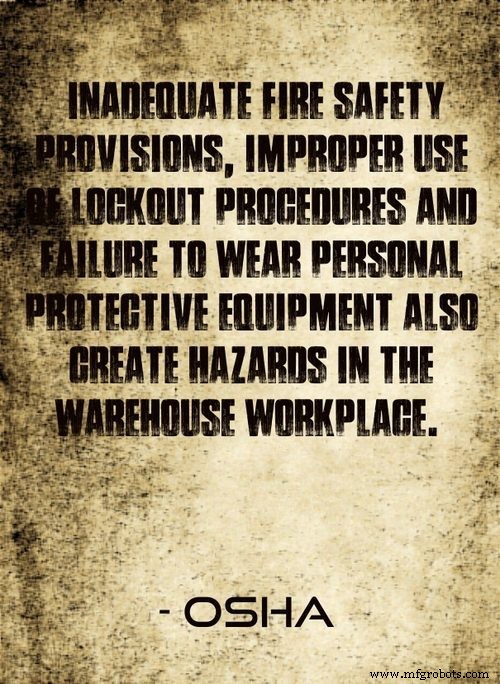
23.制定应急响应计划。 “消防安全规定不足、锁定程序使用不当以及未佩戴个人防护设备也会在仓库工作场所造成危险。雇主应制定应急计划,描述在发生紧急情况时对员工的期望,包括:
• 紧急出口位置和
疏散程序的规定;
• 所有员工
和访客的核算程序;
•灭火器和
其他应急设备的位置和使用。” – OSHA 袖珍指南,工人安全系列:仓储 , OSHA.gov;推特:@usdol
24。避免在装卸码头和集结区发生常见事故。 “装货码头或集结区是仓库中发生产品伤害和损坏的常见区域。常见危害包括:
• 产品落到员工的头、脚、胳膊和腿上;
• 内务计划薄弱导致拥堵;
• 员工从高海拔到低海拔;
• 提升码头板并不断调整;以及
• 叉车或托盘搬运车滚下码头。
“控制包括:
• 固定码头板,使其不会翻倒;
• 对负载和临时存储进行日常检查
安排;
• 从不允许叉车或托盘搬运车返回
码头边缘;
• 执行有关员工从较高码头移动的安全规则
海拔较低的地面;
• 监控指定的安全检查表West Bend;推特:@WBsilverlining
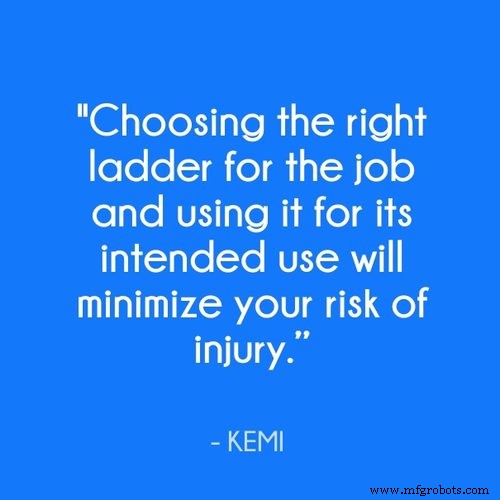
25.为仓库内的各种工作提供合适的梯子,并提供培训,以便工人可以轻松地确定最适合任务的梯子。 “物料搬运并不是仓库内唯一潜在的伤害来源。物品可能必须堆叠,以便更有效地利用空间。梯子可用于到达架子或架子的顶部。为工作选择合适的梯子并将其用于预期用途将最大限度地降低您受伤的风险。” – 仓库安全 , 凯米
26.尽快清理溢出物,并在工作人员必须在短时间内撤离该区域时从过道中清除库存和用品。 “仓库是一个有很多东西的地方。狭窄的过道、堆积如山的货物和昏暗的照明正是影响能见度的因素。如果仓库保持充足的照明并在黑暗的角落配备可以轻松打开和关闭的特殊灯,则滑倒和绊倒材料或溢出的液体是可以避免的常见事故。去除不必要的台阶或山脊,并鼓励员工永远不要将任何货物、箱子和货物无人看管地留在地板上。
“如果仓库工人需要暂时离开地板,那么他或她将材料移开很重要在保持灯亮的情况下从过道的中心。万一有东西溢出,员工应采取适当措施关闭有明显标志的区域并尽快清理。” – Tom Reddon,避免最常见仓库事故的 4 种方法 , 工作中的知识

27.只有经过培训的操作员才能使用叉车、起重机和起重机等设备。 “叉车和手推车并不是唯一可以证明是危险的仓库设备。与移动的输送机部件接触会导致严重伤害。这就是为什么保持他们的警卫就位如此重要的原因。起重机、起重葫芦和吊杆只能由训练有素的操作员操作,这些操作员有足够的知识来避免在人身上摆动负载或在负载悬挂时将手或脚从控制装置上移开。此外,在附近工作的任何人都必须注意起重机的移动;如果您在起重机下工作或站立,您就是在找麻烦。您也可能在此设备的装载方式中发现危险。重物或不平衡的负载可能会翻倒并造成严重伤害,甚至致命。” BLR.com;推特:@BLR_INC
28.使用合理的存储方法来最大程度地降低火灾风险。 “存储方法会影响相同材料的火势蔓延速度及其严重程度。例如,垂直存放的纸卷会产生堆叠效应。对于室内存储,建议的最大堆高为 4.5m。从桩顶到屋顶构件、电气配件或火灾探测器的最低点的间隙应至少为 1m。应该在墙上画一条色带,以指示材料可以堆叠的最大高度。” – N.V. Subba Rao 和 K. Ramish Ramalingham,仓库风险管理 , Cholarisk.com
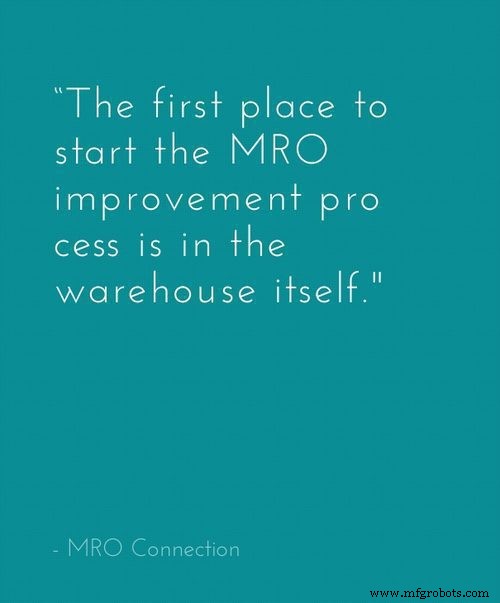
29.必须始终使用安全设备。 “在仓库中,叉车或液压小车用于提升太重的物品至关重要。必要时还应佩戴适当的眼镜和安全帽。员工应注意紧急出口,安装在屋顶的洒水器在任何时候都不应堵塞。安装安全设备是为了最大限度地减少工作场所的伤害,因此尽管开始使用它可能很耗时,但从长远来看确实会有所回报。” – 仓库安全原则:确保工作场所安全的 6 条关键准则。 , 适应提升;推特:@aalhyster
30.在醒目的位置和关键区域张贴安全期望。 “Warehouse supervisors should ensure all safety expectations are posted clearly in close proximity to all equipment—forklifts, hydraulic dollies, hand jacks, etc. Doing so assures that employees have constant visual reminders of the inherent dangers of using such equipment, and the safety precautions they should take to avoid injury.” – Warehouse Safety Checklist:8 Things Every Manager Should Review , Legacy Supply Chain Services; Twitter:@legacyscs
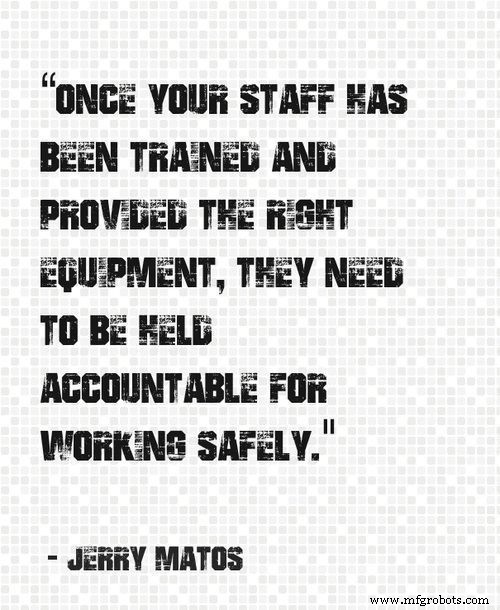
31. Establish accountability and give staff a sense of ownership over warehouse safety practices. “Once your staff has been trained and provided the right equipment, they need to be held accountable for working safely. This must apply to everyone in your warehouse. You cannot overlook bad habits of supervisors while reprimanding a dockworker. How you handle safety infractions is up to you, but your employees must own their actions. You will see better results if you offer suggestions for safer operation at the same time you express criticism.
“You do need to document lapses in safety. Without proper records, you may not have the backup you need to take action against an employee that continues to ignore your requirements. Documentation will also help protect you if an employee is injured performing an action after they have been instructed otherwise.” – Jerry Matos, Product Specialist, Cherry’s Industrial Equipment, 6 Ways To Encourage Warehouse Safety , Industrial Distribution; Twitter:@indistwebsite
32. Consider enlisting an outside expert to identify warehouse hazards. “To help improve the safety in the workplace, consider bringing in an outsider. The outsider does not necessarily need to be a consultant or OSHA representative, but may be a business associate, or peer. The point is to have a fresh pair of eyes evaluate the warehouse. Sometimes what is seen in plain sight every day may be an overlooked hazard.” – Best Practices for Warehouse Safety , Labor Law Center
Optimizing Warehouse Operations Workflows
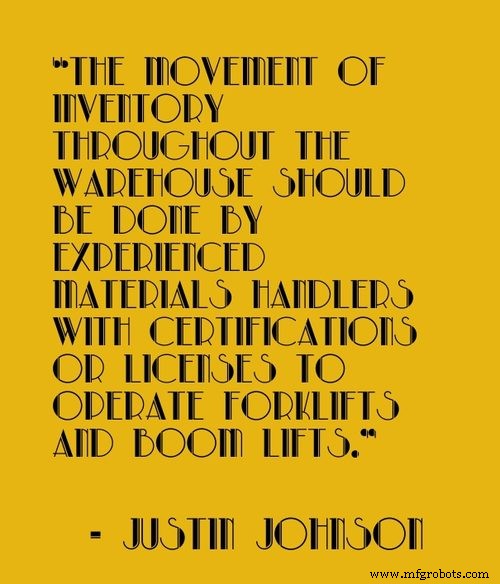
33. Clear aisles make for an efficient flow of inventory. “The movement of inventory throughout the warehouse should be done by experienced materials handlers with certifications or licenses to operate forklifts and boom lifts. These materials handlers should be able to move from one section of the warehouse to another with ease due to aisles that are not full of unstored inventory. Inventory that has not been placed in its proper bin or warehouse location can cause problems with inventory systems, especially under a FIFO, or First In, First Out, inventory system. A FIFO system ensures that the inventory that was received yesterday is moved to the shipping dock before the inventory that was received today. This inventory system reduces the chance of obsolete inventory sitting in warehouse bins.” – Justin Johnson, Best Practices in Warehouse Operations , Chron.com
34. Store the most frequently picked items close to the shipping area. “When considering the level of effort involved in warehouse operations, the greatest expenditure of effort is in the picking process. To gain efficiencies in picking the labor time to pick orders needs to be reduced and this can achieved in a number of ways. Companies with the most efficient warehouses have the most frequently picked items closest to the shipping areas to minimize picking time. These companies achieve their competitive advantage by constantly reviewing their sales data to ensure that the items are stored close to the shipping area are still the most frequently picked.” – Martin Murray, Supply Chain/Logistics Expert, Warehouse Best Practices , About.com

35. Implement efficient dock management practices. “Some of the most valuable square footage in the warehouse is dock space. All material must flow in and out of your docks, and these are limited in number (and not readily added to). Space on the inside and outside of the docks is some of the busiest in your warehouse. Dock best practice depends on the type of inbound you receive and for many companies balancing available dock doors, equipment, and labor is difficult, so the receiving dock becomes a choke point in the supply chain. Docks in today’s warehouses must be more flexible and must support a variety of receipts that are coming in at a faster rate and in greater frequency and with just in-time and VMI programs, smaller quantities and mixed pallets.” – Warehousing &Fulfillment Process Benchmark &Best Practice Guide , Warehouse Education and Research Council (WERC); Twitter:@WERC
36. Calculate resource and space requirements based on expected receipts and current backloads. “Put-away is the process of moving material from the dock and transporting it to a warehouse’s storage, replenishment, or pick area. Best-practice companies manage the put-away area by calculating resource and space requirements based on expected receipts and current backlogs. Best practice is to put away product the same day it’s received, because not doing so affects space, causes congestion, increases transaction errors, and makes product more susceptible to damage. In a busy warehouse, it is easy to let product put-away fall behind other tasks such as picking, replenishment, shipping, and loading. But pulling away resources from put-away tasks can affect fill rates by not having product in pick racks. This can bring about congestion in staging areas that overflow into aisles. Delaying put-away may also result in product damage as the merchandise is moved, again and again, to make way for higher priority receipts. Proper staffing of the put-away team will support down stream processes of picking and shipping, and in the long run lead to better customer order fill rates.” – Kate Vitasek, Best Practices in Material Handling and Put-away , Multi-Channel Merchant; Twitter:@mcmerchant

37. Establish stable warehouse operations within the warehouse first, then work to improve pre-planning efforts. “The first place to start the MRO improvement process is in the warehouse itself. Once stable warehouse operations have been established, maintenance and operations can work to improve their pre-planning efforts. At first glance, this appears to be a daunting task. Trying to organize, store, identify and properly manage thousands of disparate inventory items, with different and seemingly unpredictable demand patterns, creates an environment in which it is difficult to succeed. Creating an implementation strategy that is simple, straight forward and thorough, is critical to a successful MRO Warehouse Operation.” – Creating the “Perfect Warehouse,” MRO Connection
38. Maximize vertical space. “On the production floor, where space can be limited, it’s important to take advantage of every inch of available space (floor to ceiling). As noted in an Occupational Health &Safety article, solutions such as pallet racking can lead to safer working conditions as well as increased efficiency in the warehouse. Pallet racking, the most common way of storing pallet loads in the world, is an easy-to-use storage solution; it’s used in the vast majority of warehouses, manufacturing facilities, commercial warehouse operations, and even retail stores.” – Jennie Dannecker, 10 Ideas for More Efficient &Productive Warehouse Operations , Cerasis; Twitter:@Cerasis

39. Use your WMS software to sequence orders and organize the workflow. “Sequencing your orders by pick path, and batching together single lines, same-zone orders, and difficult picks – such as non-conveyable items – saves tremendous time on the distribution center floor. Again, your WMS software should be able to organize the workflow and optimize sequence performance.” – 10 Ideas for a More Efficient Warehouse Operation , ShelfPlus
40. Communicate effectively — and often. “Clearly communicating to workers your organizational goals and the processes to achieve them is one key to effective warehousing operations. When managers fail to create an environment of open and clear communication, employee productivity suffers, resulting in high turnover and wasted resources.” – Increasing Warehouse Productivity , Inbound Logistics; Twitter:@ILmagazine
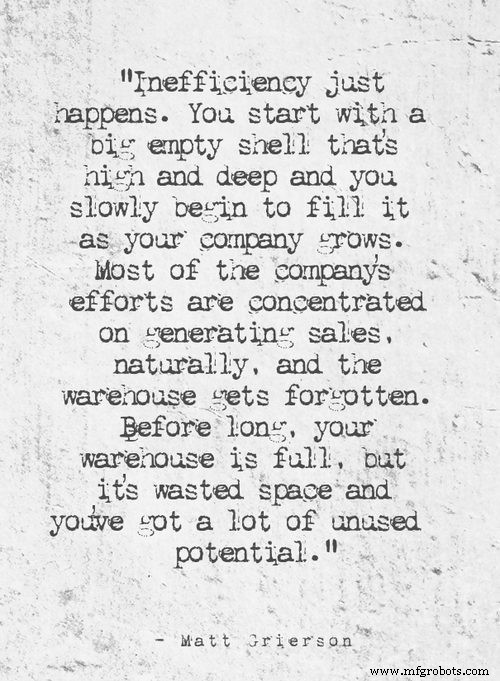
41. Make smart use of floor space. “Matt Grierson is managing director at Dexion, which provides industrial and commercial storage solutions across Europe. He says that only a small fraction of the companies that approach him believing they need to move into larger premises really do need to. The rest have enough space already, they’re just using it badly.
“Grierson says:‘Inefficiency just happens. You start with a big empty shell that’s high and deep and you slowly begin to fill it as your company grows. Most of the company’s efforts are concentrated on generating sales, naturally, and the warehouse gets forgotten. Before long, your warehouse is full, but it’s wasted space and you’ve got a lot of unused potential.’
“By using your space efficiently, your staff can get jobs done quicker and can complete more jobs in a day, you save on purchase or rent by not expanding unnecessarily, and you can go longer before the huge burden of relocating into bigger premises.
“Grierson adds:‘There are a lot of shelving options. Two-tier or mezzanine, fixed or mobile. If you can squeeze your rows of shelving together, and only open them up when access is required, you can save 50% of your floor space.'” – Tim Aldred, How to manage an effective warehouse , The Guardian; Twitter:@tim_aldred
42. Design storage systems to meet the needs of the current and planned mix of storage types. “The layout of a warehouse that supports an adjoining manufacturing facility will have different requirements than a facility supporting product distribution to stores or a facility that supports end-user fulfillment. Some operations place emphasis on replenishment of product to the point of use, others on product picking or order fulfillment.
“Regardless of the ultimate mission of the warehouse, best-practice companies have designed storage systems to meet the needs of the current and planned mix of storage types. They have optimized storage locations and layouts to fit product without the need to restack or repalletize it once received. The warehouse management system will track storage location profiles and properly assign product to the best storage location. As a result, best-practice companies have excellent cube-fill rates.
“In addition to optimizing the cubic fill of storage locations, best practice is to minimize travel time. If a product is in high demand it should be placed closer to its next point of use. In this case demand should be based on the number times the product is required, not on the number of units required. The difficulty of retrieval should also be considered in travel time. Higher-demand product should be placed on the most easily accessed storage space, typically floor level for racking and between waist and shoulder level in pick racks.” – Kate Vitasek, Storage and Inventory Control Best Practices , Multi-Channel Merchant; Twitter:@mcmerchant
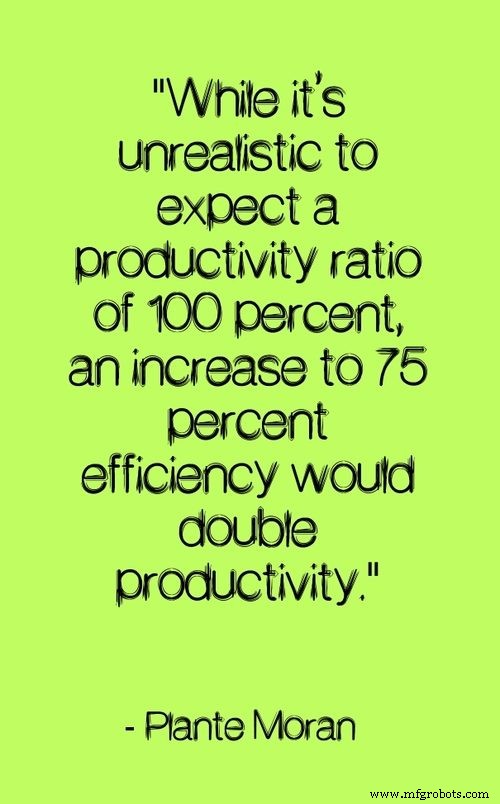
43. Reduce order processing cycle time. “In one analysis of a distribution operation, data revealed that the overall order processing cycle time was extremely inefficient. Of the total order cycle time, it was actually being worked on only 37.9 percent of the time. Six percent of the time was wasted while people dealt with problems such as waiting for lift equipment, computer issues, interruptions, and blocked aisles, and the remaining 56.1 percent of the time orders sat idle. This is a low productivity ratio by any standard. While it’s unrealistic to expect a productivity ratio of 100 percent, an increase to 75 percent efficiency would double productivity. How can this opportunity be captured? ” – Are Your Warehouse Operations Lean? , Plante Moran; Twitter:@PlanteMoran
44. Implement and maintain operational standards in all functional areas. “Maintain and use standards in all major functional areas. This will assist management in identifying systemic bottlenecks such as aisle congestion or other workflow problems.” – Warehouse Workflow Handbook , WERC; Twitter:@WERC

45. Improve cycle time utilization through lean applications. “Lean applications can help improve cycle time utilization, reduce costs, increase productivity, and increase customer satisfaction. To get to lean, begin with conducting a time study and analysis of the current order fulfillment process. Identify non-value added steps and note the amount of time spent on each of them. Then, assess overall workflow in an attempt to reveal inefficient product pick paths, wasted motion, excessive delays, excessive footsteps, aisle and work area congestion, and equipment availability.” – Chris Calderone, Creating a Lean HME Warehouse Operation , Lean Homecare; Twitter:@LeanHomecare
Best Practices for Improving Inventory Management
46. Reduce inventory inefficiencies. “Warehouse management systems are critical to tracking the various stages of the manufacturing process. From production to delivery, officials need to be able to monitor inventory as it makes its way through the supply chain. This is especially relevant during periods of growth, as a sudden influx of inventory may overwhelm employees on the floor, leading to costly errors. Without a robust inventory control system, managers may have difficulties locating materials or finished products, causing them to dedicate more manpower and resources to this process. Officials with Land Rover dealt with this issue on a regular basis, according to Zebra Technologies. When vehicles rolled off the assembly line, they were subject to a number of finalization processes, including testing, setting configurations and addressing any existing errors. Managers had a great deal of difficulty identifying where individual items were located along the supply chain, resulting in a high degree of uncertainty and risk.” – Nancy Master, Identifying Warehouse Management Best Practices , RFgen; Twitter:@RFgenSoftware
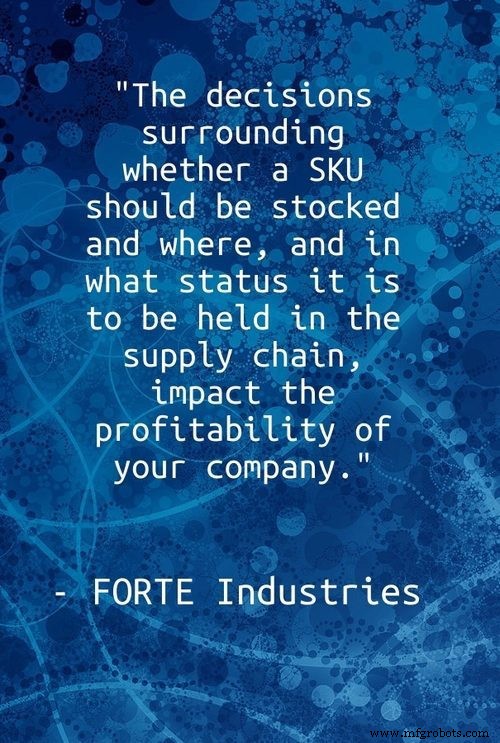
47. SKU profiling can facilitate profitability. “Understanding how every SKU carried in your distribution center (DC) can – and should – contribute to your company’s bottom line – is the best way to design and run DC operations. Here’s why:Each SKU has a potential cost impact that goes well beyond its actual purchase price. The decisions surrounding whether a SKU should be stocked and where, and in what status it is to be held in the supply chain, impact the profitability of your company. And from a selfish standpoint, these same decisions, made without sufficient evaluation, can rob your distribution center of capacity and efficiency.” FORTE Industries
48. Establish minimum holding stocks to cover lead times. “It has been established that the role of inventory management is to ensure that stock is available to meet the needs of the beneficiaries as and when required.
“Inventory represents a large cost to the humanitarian supply chain. This is made up of the cost of the inventory itself, plus the cost of transporting the goods, cost of managing the goods (labor, fumigation, repackaging, etc) and keeping the goods in warehouses. The inventory manager’s job is to make inventory available at the lowest possible cost.
“In order to achieve this, the inventory manager must ensure a balance between supply and demand by establishing minimum holding stocks to cover lead-times. To achieve this, the inventory manager must constantly liaise with the programs to keep abreast of changing needs and priorities. The warehouse must always have sufficient stocks to cover the lead-time for replacement stocks to avoid stock-outs.” – Warehousing and Inventory Management , Logistics Cluster; Twitter:@logcluster
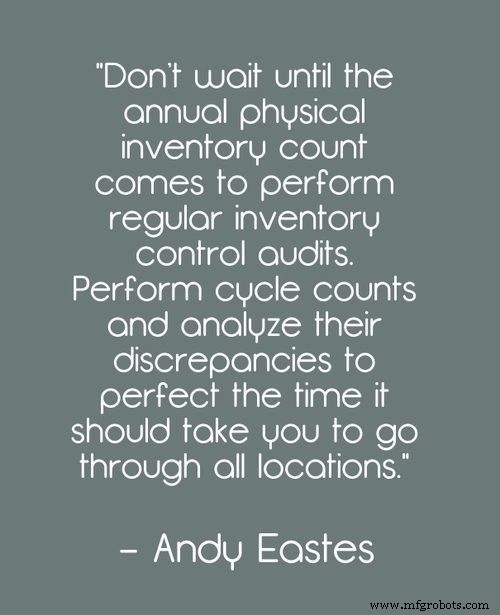
49. Perform cycle counts and analyze discrepancies. “Don’t wait until the annual physical inventory count comes to perform regular inventory control audits. Perform cycle counts and analyze their discrepancies to perfect the time it should take you to go through all locations. It’s good to have cycle counts go through all locations every quarter so that you have a more accurate back-office system.” – Andy Eastes, CEO of Agile Harbor, 10 Ways to improve warehouse efficiency and inventory management without software , SKUVault; Twitter:@skuvault
50. Develop an approved stock list for each location. “When you stock an item you are making a commitment—a commitment that the product will be available in reasonable quantities for immediate shipment or delivery to customers. Most distributors’ warehouses are filled with two things:‘stock’ and ‘stuff.’ Stock is the material you intend to be in the warehouse. That is, the items necessary to meet or exceed customers’ expectations of product availability. Stuff is everything else. You must separate the stock from the stuff in each of your warehouses. Our goal is to liquidate the stuff and arrange the stock items in such a way to minimize the cost of filling customer orders.” – John Schreibfeder, President of Effective Inventory Management, Inc., The First Step to Achieving Effective Inventory Control , via Lanham Associates; Twitter:@LanhamAssoc
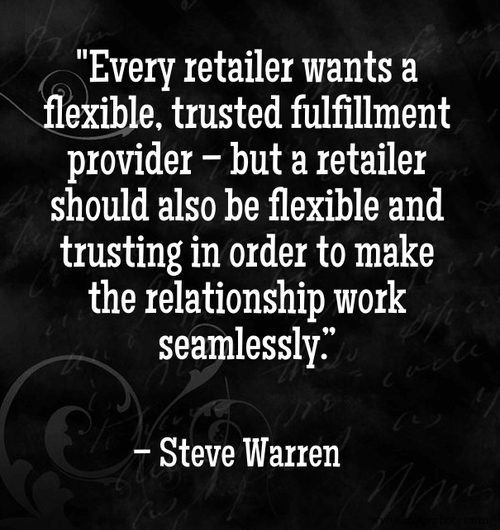
51. Maintain constant, consistent communication with vendors. “A good relationship with your vendors is crucial to your company’s success – especially if you outsource any part of your retail operations. Your fulfillment provider becomes your brand in the eyes of the customer, so it’s important that they understand your plans for your inventory as well as you do.
“This means constant communication of your promotional plans, product information, and upcoming releases. Every retailer wants a flexible, trusted fulfillment provider – but a retailer should also be flexible and trusting in order to make the relationship work seamlessly.” – Steve Warren, 4 Tips for Effective Inventory Management , Multi-Channel Merchant; Twitter:@mcmerchant
52. Achieve inventory analysis efficiency. “With solid inventory analysis, you can ensure that you are investing in the right amount of the right products to remain competitive. By developing and using a comprehensive set of tools to closely monitor the performance of your inventory, you can achieve more of your goals more efficiently.” – Bill Knapp, Socius, Beyond Software:6 Effective Inventory Management Practices , featured on the ERP Software Blog; Twitter:@erpsoftwareblog and @mssocius
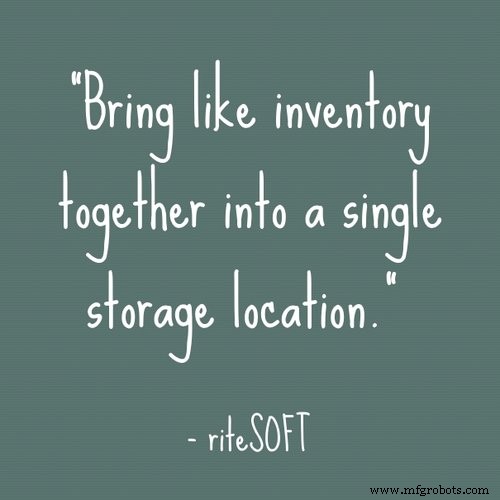
53. Understand the warning signals. “The easiest way to identify that you have too much—or the wrong inventory—is the amount of dust settled on the product in storage. If you see more than ½ inch of dust, then that’s likely a sign of obsolete inventory. However, there are other, more specific indicators that inventory management issues need to be addressed.
“If there are significant discrepancies between the book inventory and physical inventory, this is a direct indicator that there is a problem with inventory management. Another distinct indicator is when your warehouse staff is having trouble locating inventory on a timely basis—an issue that’s particularly critical when FIFO, batch/lot number or serial number controls are involved.
“The issue of locating specific inventory is typically tied to inventory discrepancies. And, of course, if you’ve seen a trend in the increased use of outside storage space, then this can indicate another ongoing inventory management issue.” – Norm Saenz and Don Derewecki of St. Onge, Inventory Management 101:Time to revisit the principles , Logistics Management; Twitter:@LogisticsMgmt
54. Use both fixed and moveable tracking options. “When companies think of warehouse tracking, they think primarily of movable tracking options, tracking the units and pallets that actually get moved around the warehouse and sent up the supply chain. This is only one part of the warehouse management process – do not forget the benefits that come with used fixed trackers, too! By tracking fixed warehouse assets, you are able to assign and manage destinations much more easily, and arrange strategy protocols as needed without mass confusion. It is better to think of warehouse tracking in two different parts, one fixed and one movable.” – Justin Velthoen, 7 Tips for Warehouse Inventory Management , QStock Inventory; Twitter:@QStockInventory

55. For physical count inventory, keep like inventory together in a single location. “Bring like inventory together into a single storage location. The same part shouldn’t be in several storage areas unless physical size dictates a limitation. In that case, keep available quantities to a minimum and move remainder to a location that isn’t part of the easily accessible storage (overstock location).” – Warehouse Management Tips for Physical Count Inventory , riteSOFT; Twitter:@ritesoft
Asset Tracking Solutions from Camcode:
- Inventory Control
- Inventory Management
- 自定义铝箔标签
- 仓库标志
- 过道标志
- Stainless Steel Tags
- 地板标签
- Security Labels
- Magnetic Labels
- 资产标签
工业技术
- CMMS 如何改进仓库管理
- 液压系统的最佳实践和维护技巧
- 25 个最佳仓库优化软件工具
- 6 仓库库存跟踪最佳实践
- 50 个 IT 资产管理最佳实践
- 仓库生产力:15 位专家揭示了提高仓库运营效率和生产力的重要技巧
- 仓库库存管理终极指南:关于库存管理框架、最佳实践、软件、移动性和低技术库存解决方案的 80 个值得信赖的资源
- 最佳仓库管理演示和幻灯片:关于简化仓库运营、提高生产力等的 50 个深入资源
- 顶级仓库管理培训资源:50 门课程、网络研讨会、教程等,以掌握仓库管理实践
- 仓库管理软件:提高仓库效率、减少开销和增加利润的 52 种最佳工具和系统
- 仓库货架技巧和策略:50 个专家仓库货架理念、策略和系统以最大限度地提高生产力
- 50 篇关于教育工作者资产管理、采购、报告等方面最佳实践的信息性文章


